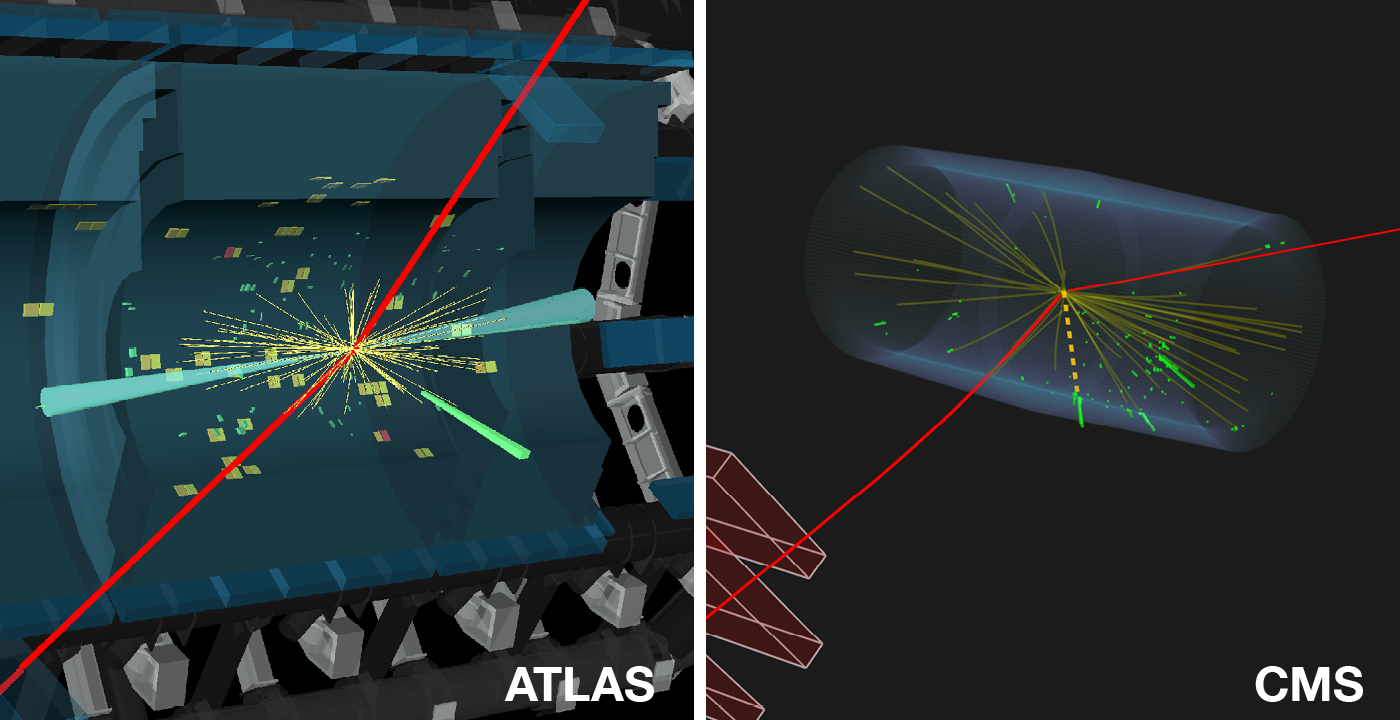LHC experiments see first evidence of a rare Higgs boson decay
Tuesday 6 June 2023

Candidate events fromATLAS (left) and CMS (right) for a Higgs boson decaying into a Z bosonand a photon,with the Z bosondecayinginto a pair of muons. (Image: CERN) The discovery of the Higgs boson at CERN’s Large Hadron Collider
(LHC) in 2012 marked a significant milestone in particle physics. Since
then, the ATLAS and CMS collaborations have been diligently
investigating the properties of this unique particle and searching to
establish the different ways in which it is produced and decays into
other particles. At the Large Hadron Collider Physics (LHCP)
conference this week, ATLAS and CMS report how they teamed up to find
the first evidence of the rare process in which the Higgs boson decays
into a Z boson, the electrically neutral carrier of the weak force, and a
photon, the carrier of the electromagnetic force. This Higgs boson
decay could provide indirect evidence of the existence of particles
beyond those predicted by the Standard Model of particle physics. The
decay of the Higgs boson into a Z boson and a photon is similar to that
of a decay into two photons. In these processes, the Higgs boson does
not decay directly into these pairs of particles. Instead, the decays
proceed via an intermediate "loop" of “virtual” particles that pop in
and out of existence and cannot be directly detected. These virtual
particles could include new, as yet undiscovered particles that interact
with the Higgs boson. The Standard Model predicts that, if the
Higgs boson has a mass of around 125 billion electronvolts,
approximately 0.15% of Higgs bosons will decay into a Z boson and a
photon. But some theories that extend the Standard Model predict a
different decay rate. Measuring the decay rate therefore provides
valuable insights into both physics beyond the Standard Model and the
nature of the Higgs boson. Previously, using data from
proton–proton collisions at the LHC, ATLAS and CMS independently
conducted extensive searches for the decay of the Higgs boson into a Z
boson and a photon. Both searches used similar strategies, identifying
the Z boson through its decays into pairs of electrons or muons –
heavier versions of electrons. These Z boson decays occur in about 6.6%
of the cases. In these searches, collision events associated with
this Higgs boson decay (the signal) would be identified as a narrow
peak, over a smooth background of events, in the distribution of the
combined mass of the decay products. To enhance the sensitivity to the
decay, ATLAS and CMS exploited the most frequent modes in which the
Higgs boson is produced and categorised events based on the
characteristics of these production processes. They also used advanced
machine-learning techniques to further distinguish between signal and
background events. In a new study, ATLAS and CMS have now joined
forces to maximise the outcome of their search. By combining the data
sets collected by both experiments during the second run of the LHC,
which took place between 2015 and 2018, the collaborations have
significantly increased the statistical precision and reach of their
searches. This collaborative effort resulted in the first evidence
of the Higgs boson decay into a Z boson and a photon. The result has a
statistical significance of 3.4 standard deviations, which is below the
conventional requirement of 5 standard deviations to claim an
observation. The measured signal rate is 1.9 standard deviations above the Standard Model prediction. “Each
particle has a special relationship with the Higgs boson, making the
search for rare Higgs decays a high priority,” says ATLAS physics
coordinator Pamela Ferrari. "Through a meticulous combination of the
individual results of ATLAS and CMS, we have made a step forward towards
unravelling yet another riddle of the Higgs boson." “The
existence of new particles could have very significant effects on rare
Higgs decay modes,” says CMS physics coordinator Florencia Canelli.
“This study is a powerful test of the Standard Model. With the ongoing third run of the LHC and the future High-Luminosity LHC, we will be able to improve the precision of this test and probe ever rarer Higgs decays.”
|